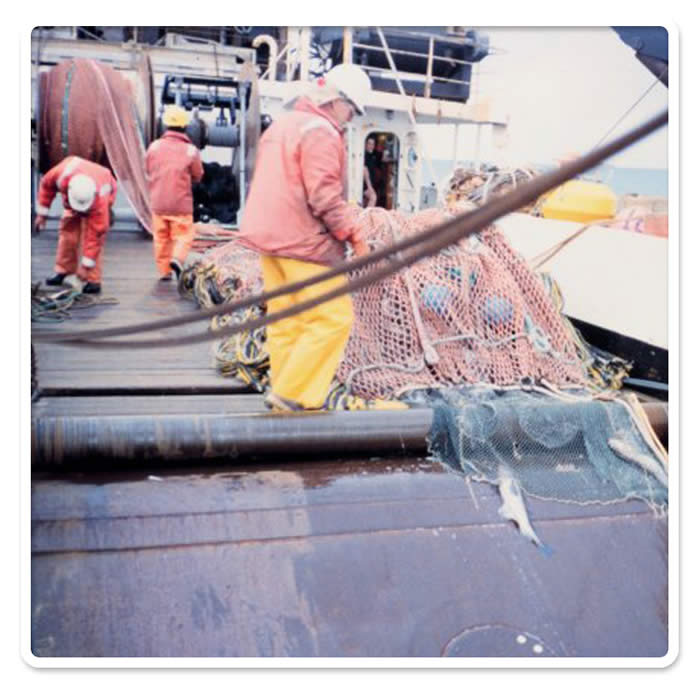Fisheries
 In terms of global effort, reported deep-water landings accounted for 6.5% of total fisheries capture in 2002 (4.7% excluding China due to uncertainty in reporting statistics), a small proportion of a global industry worth between $70-80 billion (USD) year-1. Deep-sea bottom trawling, one of the most physically damaging fishing methods, is not likely to exceed a value of $300-400 million annually and contributes an estimated 0.2-0.25% of global fisheries capture weight. The trawls used in the deep sea are modified forms of shallow water trawls, sometimes fitted with rock-hopper gear and kept open by large otter boards (or trawl doors) that can weigh up to a tonne each. On some occasions the base of the net is reinforced by chains, which serve to strengthen the net, add weight or maintain close contact with the seafloor. On an average fishing excursion, these trawls are deployed for approximately 4 hours, sweeping 20-30 km of seabed at 3-5 knots. There can be up to five hauls per day, and fishing excursions often last approximately 10 days, potentially covering up to 100 km2 of seafloor. The practice of bottom trawl fishing is causing international concern due to the damage that occurs to benthic habitats during the passage of a trawl. In terms of global effort, reported deep-water landings accounted for 6.5% of total fisheries capture in 2002 (4.7% excluding China due to uncertainty in reporting statistics), a small proportion of a global industry worth between $70-80 billion (USD) year-1. Deep-sea bottom trawling, one of the most physically damaging fishing methods, is not likely to exceed a value of $300-400 million annually and contributes an estimated 0.2-0.25% of global fisheries capture weight. The trawls used in the deep sea are modified forms of shallow water trawls, sometimes fitted with rock-hopper gear and kept open by large otter boards (or trawl doors) that can weigh up to a tonne each. On some occasions the base of the net is reinforced by chains, which serve to strengthen the net, add weight or maintain close contact with the seafloor. On an average fishing excursion, these trawls are deployed for approximately 4 hours, sweeping 20-30 km of seabed at 3-5 knots. There can be up to five hauls per day, and fishing excursions often last approximately 10 days, potentially covering up to 100 km2 of seafloor. The practice of bottom trawl fishing is causing international concern due to the damage that occurs to benthic habitats during the passage of a trawl.
 One of the key differences between deep sea and shallow waters is the persistence of trawling damage. The deep sea is characterised by low current speeds and sedimentation rates resulting in the long-term persistence of trawling damage. Regardless of the ecosystem, trawling scrapes and ploughs the sediment, creating areas of intense disturbance and in the process rolls large boulders, removing any epifauna. The passage of the trawl can also resuspend large quantities of sediment, which smothers organisms and reduces the abundance of some components of the benthos. The most significant and potentially persistent effect of trawling may be the damage of non-target epibenthic species such as sponges, xenophyophores and cold-water corals, but the long-term effects on marine organisms other than corals are largely unknown. One of the key differences between deep sea and shallow waters is the persistence of trawling damage. The deep sea is characterised by low current speeds and sedimentation rates resulting in the long-term persistence of trawling damage. Regardless of the ecosystem, trawling scrapes and ploughs the sediment, creating areas of intense disturbance and in the process rolls large boulders, removing any epifauna. The passage of the trawl can also resuspend large quantities of sediment, which smothers organisms and reduces the abundance of some components of the benthos. The most significant and potentially persistent effect of trawling may be the damage of non-target epibenthic species such as sponges, xenophyophores and cold-water corals, but the long-term effects on marine organisms other than corals are largely unknown. 
|
